The Automotive Roller Bearing Market is estimated to be valued at USD 33.2 billion in 2025 and is projected to reach USD 54.0 billion by 2035, registering a compound annual growth rate (CAGR) of 5.0% over the forecast period.
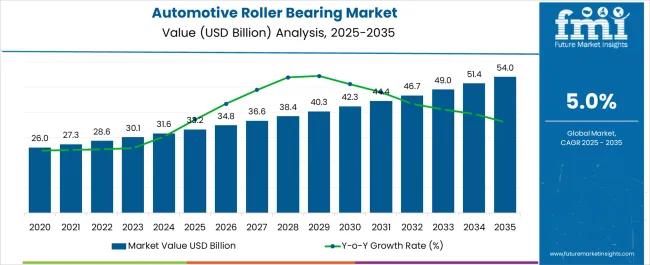
| Metric | Value |
|---|---|
| Automotive Roller Bearing Market Estimated Value in (2025 E) | USD 33.2 billion |
| Automotive Roller Bearing Market Forecast Value in (2035 F) | USD 54.0 billion |
| Forecast CAGR (2025 to 2035) | 5.0% |
The Automotive Roller Bearing market is experiencing steady growth, driven by the increasing demand for reliable, high-performance bearing solutions across the automotive industry. Rising vehicle production, particularly in emerging markets, is creating significant demand for durable and efficient roller bearings. Advancements in materials, manufacturing processes, and surface treatments are enhancing the operational life and load-carrying capacity of bearings, contributing to improved vehicle performance and safety.
Growing adoption of passenger vehicles, electric vehicles, and high-performance automotive components has further accelerated market expansion. The emphasis on reducing friction, improving fuel efficiency, and minimizing maintenance requirements is reinforcing the need for advanced roller bearings. Additionally, integration of bearings in critical powertrain, drivetrain, and chassis components is creating consistent demand across original equipment manufacturers and aftermarket channels.
Increasing investments by automotive OEMs in precision engineering and quality assurance are supporting product innovation and standardization As the automotive industry continues to prioritize performance, reliability, and efficiency, the roller bearing market is expected to sustain robust growth over the next decade.
The automotive roller bearing market is segmented by bearing type, vehicle type, sales channel, and geographic regions. By bearing type, automotive roller bearing market is divided into Cylindrical Roller Bearing, Tapered Roller Bearings, Needle Roller Bearings, Cam Follower Roller Bearings, and Spherical Roller Bearings. In terms of vehicle type, automotive roller bearing market is classified into Passenger Car, Light Commercial Vehicle (LCV), and Heavy Commercial Vehicle (HCV). Based on sales channel, automotive roller bearing market is segmented into Original Equipment Manufacturer (OEM) and Aftermarket. Regionally, the automotive roller bearing industry is classified into North America, Latin America, Western Europe, Eastern Europe, Balkan & Baltic Countries, Russia & Belarus, Central Asia, East Asia, South Asia & Pacific, and the Middle East & Africa.
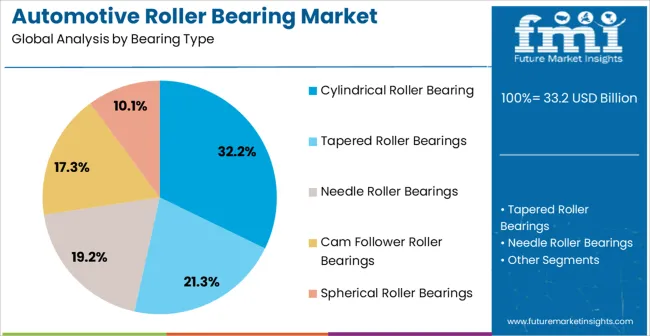
The cylindrical roller bearing segment is projected to hold 32.2% of the market revenue in 2025, establishing it as the leading bearing type. Its dominance is driven by the ability to accommodate high radial loads and moderate axial loads while maintaining minimal friction, which is critical for vehicle performance and durability. The robust design, enhanced by precision machining and advanced materials, ensures long service life and reliability in demanding automotive applications.
Cylindrical roller bearings are extensively used in transmission systems, wheel hubs, and other high-load components, where consistent performance under variable speed and temperature conditions is essential. Continuous improvements in bearing geometry, lubrication systems, and heat treatment processes have enhanced operational efficiency and reduced maintenance requirements.
Manufacturers are increasingly adopting these bearings to optimize vehicle powertrain performance, improve fuel efficiency, and reduce operational downtime As automotive production grows and vehicle performance expectations rise, cylindrical roller bearings are expected to maintain their leading market position.
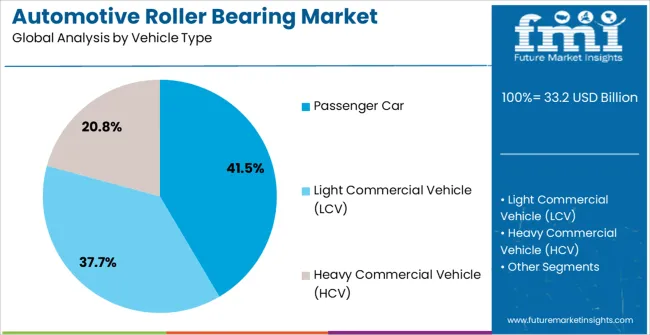
The passenger car segment is anticipated to account for 41.5% of the market revenue in 2025, making it the leading vehicle type. Growth in this segment is being driven by the increasing global demand for personal vehicles, particularly in emerging economies with expanding middle-class populations. The need for high-performance, durable bearings in passenger cars is critical to ensure safety, ride comfort, and fuel efficiency.
Automotive manufacturers are focusing on integrating advanced roller bearing technologies in powertrain, chassis, and wheel applications to enhance vehicle reliability and reduce maintenance costs. The adoption of electric and hybrid passenger cars has further reinforced the demand for precision bearings capable of handling higher rotational speeds and complex load profiles.
Continuous investments in automotive R&D and stringent quality standards for components are supporting the deployment of cylindrical and other high-performance roller bearings With sustained passenger vehicle production and growing technological advancements, this segment is expected to remain a key driver of revenue in the roller bearing market.
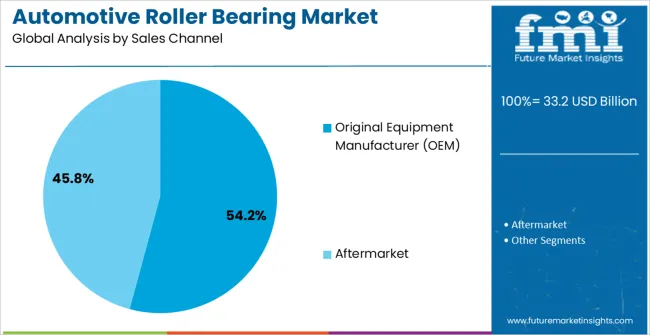
The original equipment manufacturer (OEM) sales channel segment is expected to hold 54.2% of the market revenue in 2025, establishing it as the leading distribution channel. Growth in this segment is being driven by the preference for high-quality, factory-integrated bearings that ensure consistent performance and reliability in vehicles. OEM partnerships allow manufacturers to supply bearings directly to automotive assembly lines, maintaining adherence to strict specifications and quality standards.
The OEM channel is favored for new vehicle production, particularly in passenger cars, commercial vehicles, and electric vehicles, where component reliability and compliance with regulatory standards are critical. Manufacturers benefit from long-term contracts, predictable demand, and integration support, which strengthen adoption through this channel.
Increasing focus on reducing operational downtime, enhancing fuel efficiency, and meeting safety and performance standards is reinforcing the reliance on OEMs for roller bearing supply As vehicle production continues to rise globally, the OEM channel is expected to remain the primary driver of market growth, supported by strong collaboration between bearing suppliers and automotive manufacturers.
Automotive roller bearings are used for supporting rotating shafts in mechanical equipment. Automotive roller bearings are simple tools which can be precision manufactured in mass production quantities. They are generally used as an alternative of ball bearings as they can support heavier radial loads. In general applications, there are either one or two roller bearings supporting a rotating shaft.
Automotive roller bearings are manufactured in different configurations and sizes, are relatively inexpensive and require very little maintenance. Moreover, the size and type of the bearings depend upon the type of vehicle and the amount of load to be carried out. There are numerous types of roller bearings available in market including cylindrical, spherical, tapered and cam follower roller bearing.
With advancement in technology, manufacturers are focusing on improving the quality of the material used for manufacturing roller bearings by using cleaner steel materials. Moreover, focus on increasing the load bearing capacity of automotive roller bearings has also increased significantly in the past years.
With increasing focus on designing compact vehicles the space constraint has increased considerably, owing to this manufacturers are focusing on designing compact bearings with improved performance characteristics.
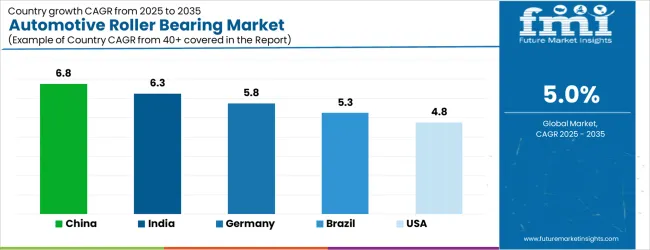
| Country | CAGR |
|---|---|
| China | 6.8% |
| India | 6.3% |
| Germany | 5.8% |
| Brazil | 5.3% |
| USA | 4.8% |
| UK | 4.3% |
| Japan | 3.8% |
The Automotive Roller Bearing Market is expected to register a CAGR of 5.0% during the forecast period, exhibiting varied country level momentum. China leads with the highest CAGR of 6.8%, followed by India at 6.3%. Developed markets such as Germany, France, and the UK continue to expand steadily, while the USA is likely to grow at consistent rates. Japan posts the lowest CAGR at 3.8%, yet still underscores a broadly positive trajectory for the global Automotive Roller Bearing Market. In 2024, Germany held a dominant revenue in the Western Europe market and is expected to grow with a CAGR of 5.8%. The USA Automotive Roller Bearing Market is estimated to be valued at USD 12.5 billion in 2025 and is anticipated to reach a valuation of USD 12.5 billion by 2035. Sales are projected to rise at a CAGR of 0.0% over the forecast period between 2025 and 2035. While Japan and South Korea markets are estimated to be valued at USD 1.7 billion and USD 863.4 million respectively in 2025.
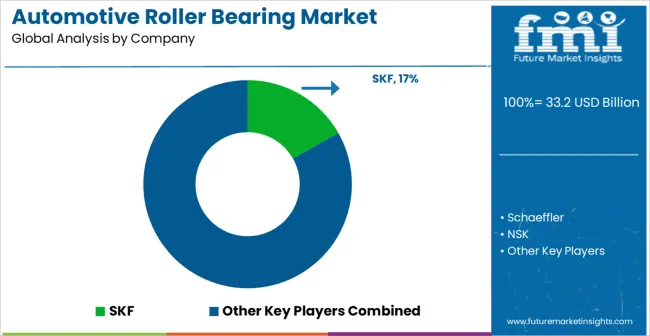
| Item | Value |
|---|---|
| Quantitative Units | USD 33.2 Billion |
| Bearing Type | Cylindrical Roller Bearing, Tapered Roller Bearings, Needle Roller Bearings, Cam Follower Roller Bearings, and Spherical Roller Bearings |
| Vehicle Type | Passenger Car, Light Commercial Vehicle (LCV), and Heavy Commercial Vehicle (HCV) |
| Sales Channel | Original Equipment Manufacturer (OEM) and Aftermarket |
| Regions Covered | North America, Europe, Asia-Pacific, Latin America, Middle East & Africa |
| Country Covered | United States, Canada, Germany, France, United Kingdom, China, Japan, India, Brazil, South Africa |
| Key Companies Profiled | SKF, Schaeffler, NSK, NTN Corporation, JTEKT, Timken Company, C&U Group, LYC Bearing Corporation, Nachi Fujikoshi Corp., Zhejiang Tianma Bearing Group Co.Ltd., Wafangdian Bearing Group Corp., RBC Bearings, and Harbin Bearing Manufacturing Co.Ltd. |
The global automotive roller bearing market is estimated to be valued at USD 33.2 billion in 2025.
The market size for the automotive roller bearing market is projected to reach USD 54.0 billion by 2035.
The automotive roller bearing market is expected to grow at a 5.0% CAGR between 2025 and 2035.
The key product types in automotive roller bearing market are cylindrical roller bearing, tapered roller bearings, needle roller bearings, cam follower roller bearings and spherical roller bearings.
In terms of vehicle type, passenger car segment to command 41.5% share in the automotive roller bearing market in 2025.






Our Research Products

The "Full Research Suite" delivers actionable market intel, deep dives on markets or technologies, so clients act faster, cut risk, and unlock growth.

The Leaderboard benchmarks and ranks top vendors, classifying them as Established Leaders, Leading Challengers, or Disruptors & Challengers.

Locates where complements amplify value and substitutes erode it, forecasting net impact by horizon

We deliver granular, decision-grade intel: market sizing, 5-year forecasts, pricing, adoption, usage, revenue, and operational KPIs—plus competitor tracking, regulation, and value chains—across 60 countries broadly.

Spot the shifts before they hit your P&L. We track inflection points, adoption curves, pricing moves, and ecosystem plays to show where demand is heading, why it is changing, and what to do next across high-growth markets and disruptive tech

Real-time reads of user behavior. We track shifting priorities, perceptions of today’s and next-gen services, and provider experience, then pace how fast tech moves from trial to adoption, blending buyer, consumer, and channel inputs with social signals (#WhySwitch, #UX).

Partner with our analyst team to build a custom report designed around your business priorities. From analysing market trends to assessing competitors or crafting bespoke datasets, we tailor insights to your needs.
Supplier Intelligence
Discovery & Profiling
Capacity & Footprint
Performance & Risk
Compliance & Governance
Commercial Readiness
Who Supplies Whom
Scorecards & Shortlists
Playbooks & Docs
Category Intelligence
Definition & Scope
Demand & Use Cases
Cost Drivers
Market Structure
Supply Chain Map
Trade & Policy
Operating Norms
Deliverables
Buyer Intelligence
Account Basics
Spend & Scope
Procurement Model
Vendor Requirements
Terms & Policies
Entry Strategy
Pain Points & Triggers
Outputs
Pricing Analysis
Benchmarks
Trends
Should-Cost
Indexation
Landed Cost
Commercial Terms
Deliverables
Brand Analysis
Positioning & Value Prop
Share & Presence
Customer Evidence
Go-to-Market
Digital & Reputation
Compliance & Trust
KPIs & Gaps
Outputs
Full Research Suite comprises of:
Market outlook & trends analysis
Interviews & case studies
Strategic recommendations
Vendor profiles & capabilities analysis
5-year forecasts
8 regions and 60+ country-level data splits
Market segment data splits
12 months of continuous data updates
DELIVERED AS:
PDF EXCEL ONLINE
Automotive Bearing and Clutch Component Aftermarket Size and Share Forecast Outlook 2025 to 2035
Automotive Wheel Bearing Aftermarket Analysis - Size, Share, and Forecast 2025 to 2035
Automotive Wheel Bearings Market
Automotive Engine Bearings Market
Automotive Microcontroller Market Size and Share Forecast Outlook 2025 to 2035
Automotive Wheel Hub Bearing Aftermarket Analysis by Product Type, Inner Diameter, Vehicle Type, Sales Channel, and Region Forecast through 2035
Automotive Airbag Controller Unit Market Size and Share Forecast Outlook 2025 to 2035
ASEAN Automotive Bearings Market Size and Share Forecast Outlook 2025 to 2035
Automotive Connecting Rod Bearing Market -Trends & Forecast 2025 to 2035
Automotive Fault Circuit Controller Market Size and Share Forecast Outlook 2025 to 2035
Demand for Automotive Deep Groove Ball Bearings in USA Size and Share Forecast Outlook 2025 to 2035
APAC Automotive Bearing Market Growth – Trends & Forecast 2022-2032
Automotive Direct Liquid Cooling IGBT Module Market Size and Share Forecast Outlook 2025 to 2035
Automotive Hoses and Assemblies Market Size and Share Forecast Outlook 2025 to 2035
Bearing Steel Balls for New Energy Vehicles Market Size and Share Forecast Outlook 2025 to 2035
Automotive Network Testing Market Size and Share Forecast Outlook 2025 to 2035
Automotive Performance Part Market Size and Share Forecast Outlook 2025 to 2035
Roller Gear Cam Unit Market Size and Share Forecast Outlook 2025 to 2035
Automotive Carbon Ceramic Brake Market Size and Share Forecast Outlook 2025 to 2035
Automotive Camshaft Market Size and Share Forecast Outlook 2025 to 2035

Thank you!
You will receive an email from our Business Development Manager. Please be sure to check your SPAM/JUNK folder too.
Chat With
MaRIA